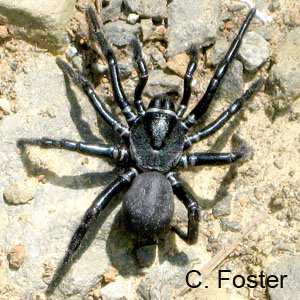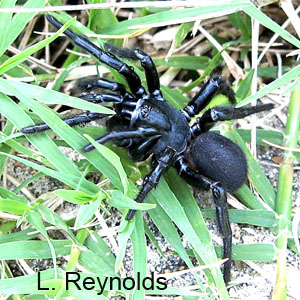Trapdoor spider
Order: Araneae
Family: Ctenizidae
Genus and species: Ummidia sp.


Trapdoor spiders live in silk-lined, underground burrows. In the United States, they are widespread in the East and in the Southwest north to Colorado. Ummidia is the most speciose genus with about 50 species, several of which are undescribed. Only Ummidia audouini (Lucas) and U. carabivora (Atkinson) have been reported from Arkansas. Burrows are often found on sides of forested ravines. They are usually less than five inches deep and are hidden under trapdoors that are hinged on one side. The trapdoors are about one inch in diameter, and they are constructed of silk camouflaged with soil and plant debris. The spiders are nocturnal, holding the trapdoor ajar at night while waiting to ambush passing prey. Females never wander far from their burrows. Males wander in search of mates in July and August. Spiderlings of at least some species disperse aerially by ballooning on silken threads caught in a breeze. When first disturbed, the spiders appear quite pugnacious and readily bite, but they soon calm down. In the 1920’s, Dr. W. J. Baerg, head of the Entomology Department at the University of Arkansas, allowed a trapdoor spider to insert its fangs on the inside of his third finger and remain there for about a minute and a half. He experienced no appreciable effects other than the puncture wounds.
